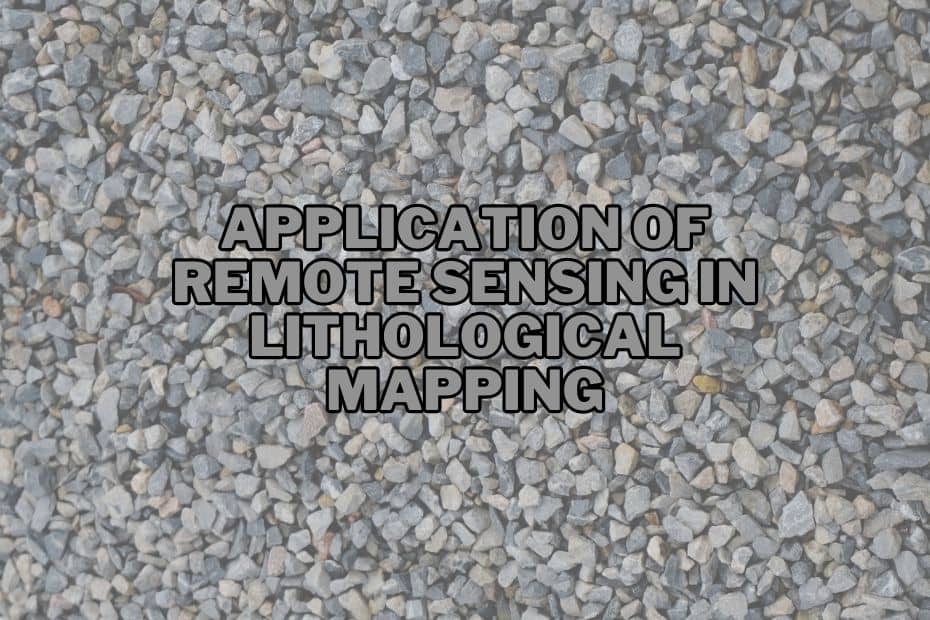Remote sensing technology has revolutionized various fields, and its applications in lithological mapping have garnered significant attention. Through the use of remote sensing techniques, we can explore the Earth’s surface and gain valuable insights into its geological composition. In this article, we will delve into the diverse application of remote sensing in lithological mapping that highlight its importance in modern geological studies.
Remote sensing plays a crucial role in lithological mapping by utilizing satellite and aerial imagery to analyze surface characteristics. It enables identification of different rock types, minerals, and geological formations, aiding in accurate geological surveys and resource exploration.
Application of Remote Sensing In Lithological Mapping
Remote sensing technology has revolutionized various fields, and its application in lithological mapping has brought about transformative changes in understanding geological features and formations. Some of the application are:
1. Identification of Geological Units
Remote sensing techniques, such as satellite imagery and aerial photography, play a crucial role in identifying different geological units on the Earth’s surface. By analyzing the spectral characteristics of various materials, remote sensing aids in distinguishing between rock types, soil compositions, and other geological formations. This information contributes to accurate geological mapping and enhances our understanding of the Earth’s structure.
2. Mineral Exploration
Mineral exploration benefits significantly from remote sensing technology. Satellite imagery allows geologists to identify mineral indicators on the Earth’s surface, such as alterations associated with mineral deposits. This aids in targeting specific areas for detailed exploration, reducing costs and increasing the efficiency of mineral resource identification.
3. Geological Mapping
Geological mapping involves creating detailed representations of the Earth’s surface and subsurface features. Remote sensing offers a bird’s-eye view, enabling geologists to create comprehensive and accurate geological maps. This is especially valuable in areas with rugged terrain or limited accessibility, where traditional field-based mapping might be challenging.
4. Environmental Monitoring
Remote sensing is a powerful tool for monitoring environmental changes related to lithology. By comparing satellite images taken at different times, scientists can track alterations in land cover, identify erosion patterns, and detect changes in vegetation. This information contributes to understanding the impact of natural processes and human activities on the landscape.
5. Hydrocarbon Exploration
The use of remote sensing in hydrocarbon exploration has gained prominence. Satellite-based techniques help detect hydrocarbon seepages on the Earth’s surface, providing valuable insights into potential oil and gas reservoirs beneath the ground. This aids in selecting drilling sites and optimizing exploration efforts.
6. Geological Hazards Assessment
Remote sensing contributes to assessing and mitigating geological hazards such as landslides, earthquakes, and volcanic eruptions. By monitoring surface changes and anomalies, scientists can predict and manage potential hazards, safeguarding communities and infrastructure.
7. Groundwater Exploration
Remote sensing techniques assist in locating potential groundwater resources. By analyzing surface features and vegetation patterns, geologists can infer the presence of underground water reservoirs. This information is crucial for sustainable water resource management.
8. Terrain Analysis
Terrain analysis involves studying the topography of an area to understand its geological history. Remote sensing provides elevation data and three-dimensional models that aid geologists in deciphering past geological processes, including erosion, sedimentation, and tectonic activity.
9. Impact Crater Studies
Remote sensing enables the study of impact craters on Earth and other celestial bodies. By analyzing satellite images and remote sensing data, scientists gain insights into the formation and evolution of impact structures, shedding light on past geological events.
10. Geothermal Resource Assessment
Remote sensing is employed in assessing geothermal resources. By detecting thermal anomalies on the Earth’s surface, scientists can identify areas with geothermal potential, aiding in the exploration and utilization of clean energy sources.
11. Coastal Geology
Coastal areas are influenced by complex geological processes. Remote sensing helps monitor coastal erosion, sediment transport, and changes in shoreline configurations. This information is vital for coastal management and protection.
12. Planetary Geology
Remote sensing techniques extend beyond Earth, enabling planetary geology studies. Satellite missions provide valuable data about the geology of other celestial bodies, enhancing our understanding of their geological history and evolution.
Conclusion
In this article, we’ve explored the vast landscape of remote sensing applications in lithological mapping. From identifying geological units and mineral exploration to environmental monitoring and planetary geology, remote sensing’s contributions are truly remarkable. Its ability to provide detailed and accurate information about the Earth’s surface composition and processes has opened up new avenues for scientific discovery and resource exploration.
FAQs: Application of Remote Sensing In Lithological Mapping
How does remote sensing aid in mineral exploration?
Remote sensing detects specific minerals’ spectral signatures, helping geologists locate potential mineral deposits based on unique reflectance patterns.
Can remote sensing help predict geological hazards?
Yes, remote sensing can provide rapid assessment of earthquake damage and contribute to tsunami modeling, aiding in hazard assessment and mitigation.
How does remote sensing contribute to planetary geology?
Remote sensing techniques used on Earth are also applied to planetary studies, helping scientists understand the geology and composition of other planets, such as Mars and the Moon.
How does hyperspectral imaging benefit lithological mapping?
Hyperspectral imaging detects a wide range of electromagnetic wavelengths, allowing accurate identification of minerals and rock types.
